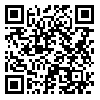Volume 14, Issue 4 (9-2011)
J Arak Uni Med Sci 2011, 14(4): 52-59 |
Back to browse issues page
Download citation:
BibTeX | RIS | EndNote | Medlars | ProCite | Reference Manager | RefWorks
Send citation to:



BibTeX | RIS | EndNote | Medlars | ProCite | Reference Manager | RefWorks
Send citation to:
Eidi A, Moghadam-kia S, Zarringhalam Moghadam J, Rezazadeh S, Eidi M. Antinociceptive effect of olive oil (Olea europaea L.) on mice. J Arak Uni Med Sci 2011; 14 (4) :52-59
URL: http://jams.arakmu.ac.ir/article-1-791-en.html
URL: http://jams.arakmu.ac.ir/article-1-791-en.html
1- , eidi@srbiau.ac.ir
2- Neuroscience Research Center, Department of Physiology, Shahid Beheshti University of Medical Sciences, Tehran, Iran
3- Institute of Medicinal Plants, ACECR, Tehran, Iran
2- Neuroscience Research Center, Department of Physiology, Shahid Beheshti University of Medical Sciences, Tehran, Iran
3- Institute of Medicinal Plants, ACECR, Tehran, Iran
Abstract: (13491 Views)
Background: In traditional medicine, Olive oil (Olea europaea L.) from Oleaceae family is known as a remedy for alleviating pain. This study investigates the antinociceptive effects of olive oil on male adult NMRI mice.
Materials and Methods: In this experimental study, using the acetic acid-induced writhing and formalin tests, the anticipative effects of olive oil were evaluated. Olive oil (1, 5, and 10 ml/kg bodyweight), morphine (10 mg/kg bodyweight), and indomethacin (10 mg/kg bodyweight), as standard drugs, were injected intraperitoneally. The control group did not receive any treatment. Data were analyzed using one-way ANOVA and Tukey test.
Results: Olive oil significantly decreased acetic acid-induced abdominal writhes (P<0.001). Olive oil could only decrease the induced pain in the second phase of the formalin test (P<0.001).
Conclusion: Olive oil decreases inflammatory pain (the second phase of the formalin test and acetic acid-induced writhing tests), but it has no significant effects on neurogenic pain (the first phase of the formalin test). Further studies are required to elucidate the antinociceptive effects of olive oil.
Send email to the article author
| Rights and permissions | |
 |
This work is licensed under a Creative Commons Attribution-NonCommercial 4.0 International License. |





